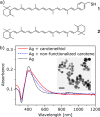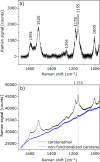Surface-Enhanced Raman and Surface-Enhanced Hyper-Raman Scattering of Thiol-Functionalized Carotene
- PMID: 28077983
- PMCID: PMC5215674
- DOI: 10.1021/acs.jpcc.6b01895
Surface-Enhanced Raman and Surface-Enhanced Hyper-Raman Scattering of Thiol-Functionalized Carotene
Abstract
A thiol-modified carotene, 7'-apo-7'-(4-mercaptomethylphenyl)-β-carotene, was used to obtain nonresonant surface-enhanced Raman scattering (SERS) spectra of carotene at an excitation wavelength of 1064 nm, which were compared with resonant SERS spectra at an excitation wavelength of 532 nm. These spectra and surface-enhanced hyper-Raman scattering (SEHRS) spectra of the functionalized carotene were compared with the spectra of nonmodified β-carotene. Using SERS, normal Raman, and SEHRS spectra, all obtained for the resonant case, the interaction of the carotene molecules with silver nanoparticles, as well as the influence of the resonance enhancement and the SERS enhancement on the spectra, were investigated. The interaction with the silver surface occurs for both functionalized and nonfunctionalized β-carotene, but only the stronger functionalization-induced interaction enables the acquisition of nonresonant SERS spectra of β-carotene at low concentrations. The resonant SEHRS and SERS spectra are very similar. Nevertheless, the SEHRS spectra contain additional bands of infrared-active modes of carotene. Increased contributions from bands that experience low resonance enhancement point to a strong interaction between silver nanoparticles and electronic levels of the molecules, thereby giving rise to a decrease in the resonance enhancement in SERS and SEHRS.
Conflict of interest statement
The authors declare no competing financial interest.
Figures






Similar articles
-
Surface Enhanced Nonlinear Raman Processes for Advanced Vibrational Probing.ACS Nano. 2024 Aug 13;18(32):20851-20860. doi: 10.1021/acsnano.4c07508. Epub 2024 Aug 1. ACS Nano. 2024. PMID: 39088308 Free PMC article. Review.
-
Surface-Enhanced Hyper Raman Spectra of Aromatic Thiols on Gold and Silver Nanoparticles.J Phys Chem C Nanomater Interfaces. 2020 Mar 19;124(11):6233-6241. doi: 10.1021/acs.jpcc.0c00294. Epub 2020 Feb 25. J Phys Chem C Nanomater Interfaces. 2020. PMID: 32395194 Free PMC article.
-
Combined near-infrared excited SEHRS and SERS spectra of pH sensors using silver nanostructures.Phys Chem Chem Phys. 2015 Oct 21;17(39):26093-100. doi: 10.1039/c5cp03844h. Epub 2015 Sep 17. Phys Chem Chem Phys. 2015. PMID: 26377486 Free PMC article.
-
Surface-Enhanced Hyper-Raman Spectra of Adenine, Guanine, Cytosine, Thymine, and Uracil.J Phys Chem C Nanomater Interfaces. 2016 Jul 21;120(28):15415-15423. doi: 10.1021/acs.jpcc.6b02753. Epub 2016 Jun 28. J Phys Chem C Nanomater Interfaces. 2016. PMID: 28077982 Free PMC article.
-
Exploring Excited State Landscapes with Surface Enhanced Hyper-Raman Spectroscopy.ACS Nano. 2024 Aug 13;18(32):20827-20834. doi: 10.1021/acsnano.4c06429. Epub 2024 Aug 1. ACS Nano. 2024. PMID: 39088723 Review.
Cited by
-
Surface Enhanced Nonlinear Raman Processes for Advanced Vibrational Probing.ACS Nano. 2024 Aug 13;18(32):20851-20860. doi: 10.1021/acsnano.4c07508. Epub 2024 Aug 1. ACS Nano. 2024. PMID: 39088308 Free PMC article. Review.
-
Surface-Enhanced Hyper Raman Spectra of Aromatic Thiols on Gold and Silver Nanoparticles.J Phys Chem C Nanomater Interfaces. 2020 Mar 19;124(11):6233-6241. doi: 10.1021/acs.jpcc.0c00294. Epub 2020 Feb 25. J Phys Chem C Nanomater Interfaces. 2020. PMID: 32395194 Free PMC article.
-
Present and Future of Surface-Enhanced Raman Scattering.ACS Nano. 2020 Jan 28;14(1):28-117. doi: 10.1021/acsnano.9b04224. Epub 2019 Oct 8. ACS Nano. 2020. PMID: 31478375 Free PMC article.
-
Design and synthesis of gold nanostars-based SERS nanotags for bioimaging applications.Nanotheranostics. 2022 Jan 1;6(1):10-30. doi: 10.7150/ntno.61244. eCollection 2022. Nanotheranostics. 2022. PMID: 34976578 Free PMC article. Review.
-
SERS detection of dopamine using metal-chelated Ag nanoshell.RSC Adv. 2024 Apr 30;14(20):14214-14220. doi: 10.1039/d4ra00476k. eCollection 2024 Apr 25. RSC Adv. 2024. PMID: 38690106 Free PMC article.
References
-
- Britton G.Functions of Carotenoid Metabolites and Breakdown Products. In Carotenoids - Vol. 4: Natural Functions, Britton George, Liaaen-Jensen S., Pfander Hanspeter, Eds.; Birkhäuser: Basel, 2008.
-
- Britton G. Structure and Properties of Carotenoids in Relation to Function. FASEB J. 1995, 9, 1551–1558. - PubMed
LinkOut - more resources
Full Text Sources
Other Literature Sources
Miscellaneous
